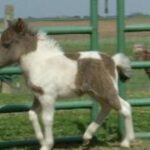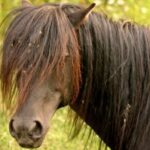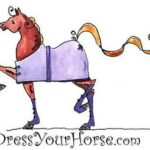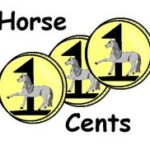What is a horse breed? This is when a stallion and a mare can produce foals that will look (and sometimes act) in a particular way. Horse and pony breeds rise and fall at the whim of humanity. These ten now extinct breeds still live on in the many current breeds that exist today.
The Turkoman
Although there are some long, lean horses called Turkomans or Turkmenes, it is highly doubtful that they are descendants from the original Turkoman, perhaps the most influential horse breed of its day. The Turkoman was thought to be the ancestor of the still existing Akhal-Teke, the Iomud (or Yamud) the Thoroughbred and possibly the Arabian. It existed around Iran and present day Turkmenistan.
Like Akhal-Tekes, Turkomans had very sparse manes and tails, very lean bodies, straight profiles and often a metallic sheen to their coats. They were unusually tall for their day, sometimes reaching 16 hands in height. Some horse historians believe that either the Byerly Turk or the Darley Arabian, two of the three foundation sires of the Thoroughbred, was actually a Turkoman. Modern day Thoroughbreds resemble an Akhal-Teke or Iomud far closer than that of an Arabian.
The Celtic Pony
When Julius Caesar reached England, the natives already had fleet and strong ponies. Not much is known today about what is now called the Celtic Pony. Depending on what book you read, the Celtic Pony resembled the very rare Exmoor pony, the Asturian pony of Northern Spain or even the Tarpan. However, it is unknown whether the latter was a separate equine species rather than a breed.
They probably averaged 12 to 13 hands high, had level backs, deep chests, thick necks and profuse manes and tails to keep out the fickle Celtic weather. They were probably mostly dark in color, tending to bays and duns. One thing that is known is that they were extremely comfortable to ride. Instead of trotting, they ambled (which is also sometimes confusingly called a pace.) They were so common that no one probably ever thought they would disappear.
The Neapolitan
This rounded, elegant riding and war horse was one of the breeds that make up the now famous Lipizzaner breed through the black stallion Conversano (foaled in 1767.) They were about 15 hands high, had Roman noses, short backs and short, strong legs. They also were agile, intelligent and willing to please. But by 1950, they were gone.
They were similar in description to several other Spanish horses such as the Andalusian and the Spanish Jennet, so they may have crossed the Atlantic early in the European conquest of the New World and contributed to North and South American breeds. The Neapolitan was also one of the breeds that founded the Italian rare riding breed, the Salerno.
The Old English Black
Sometimes known as the Old English Great Horse, this may have been a European or even Dutch breed rather than just being exclusively in England. This was a strong draft horse that, as its name suggests, was predominately black, dark bay, liver chestnut or iron grey fading to white when the animal was older. Whether it was an offshoot of the all-black Friesian or the Friesian is unknown. When selling horses in England, horse dealers sometimes were less than honest about what actual breed or breeds made up the horses they were selling.
These were thought to be the horses knights in amour rode in the Middle Ages. When armor became obsolete, they then became agricultural necessities. They are thought to be the ancestor of the Shire, the world’s tallest horse breed and the Clydesdale.
The Spanish Jennet
The name “jennet” may be confusing for modern readers since jennet means a female donkey. But in the Middle Ages, a jennet referred to a 13 to 14 hand gentle and comfortable riding horse, also known as a palfrey. They were named for their function as opposed to their pedigree.
Spanish Jennets crossed the Atlantic with the Conquistores and probably contributed to many breeds such as the Spanish Colonial Horse, the Keiger Mustang, the Florida Cracker, the Peruvian Paso and the Paso Fino. A concentrated attempt is being made to recreate the breed and the results are truly remarkable.
The Irish Hobby
This breed mostly lives on in the expression “hobby horse.” They were small ponies with remarkable stamina, perhaps similar to Celtics, that had remarkably comfortable ambling gaits. They may have been the ancestors of the Connemera, the Irish Draught and quite possibly the Thoroughbred.
As times changed, roads were built. Ambling was comfortable to ride, but not as fast as a team of long-legged horses at full trot pulling a carriage. The rise of the trotting horses lead to the Hobby’s demise, except as a toy.
The Yorkshire Coach Horse
In the 1800s, the Yorkshire Coach horse was one of the most popular breeds in the UK and exported to Germany and France. By World War II, it was gone. It was tall but well-muscled in order to be elegant enough to be seen riding but strong enough to pull a wagon. Unfortunately, they were not as fast or as flashy as other trotting breeds. Their direct descendant is thought to be the Cleveland Bay.
The Norfolk Trotter
This was the Porsche of the horse world, combining good looks with speed and strength. The Yorkshire Coach Horse delivered mail, passengers and goods all over the UK from the time it was developed about 1750 until its demise by World War I. They also provided entertainment in the new sport of harness racing. They were far more spirited than the Yorkshire Coach Horse. They were exported in great numbers to Europe, Russia and America.
The Norfolk Trotter lives on in the Standardbred, the French Trotter, the Hackney horse and pony. They also influenced the Dales pony, the Fell pony, the Hungarian Nonius and the Latvian horse of the former USSR.
The Conestoga
If the name Conestoga sounds familiar, that is because in Conestoga, Pennsyvania, large, sturdy wagons were constructed that hauled settlers out west. They also bred Conestoga horses to pull the wagons in teams of six or eight. This would be America’s very first horse breed. They arose in the early 1700s and by 1817 there were thousands.
However, the breed did not last long. At first, these were light raft horses reaching 17 hands high but perhaps because of lack of roads and lack of feed, became smaller and less muscled. One of the few engravings of a Conestoga horse, reproduced in “Storey’s Illustrated Guide to 96 Horse Breeds of North America” (Storey Publishing; 2005) shows a stallion remarkably like an old-time Morgan.
The Narragansett Pacer
This was also a horse type so numerous that in the 1800s, probably no one thought they would ever disappear. Developed in Rhode Island, they were the all-around horse breed for a young America, tractable, strong, sure-footed and with very comfortable gaits. Although called a “pacer”, they ambled or “Indian shuffled” rather than perform the pacing gait of a racing Standardbred (which is darn near impossible to ride.)
Unfortunately, Narragansett Pacers had one big flaw – they were ugly. Predominately chestnut and extraordinarily useful in both war and peace, they were considered chunky, common and pig-eyed. When flashier breeds became available to America, breeding Narragansetts became unprofitable.
However, of all extinct American breeds, none played so large a role as the Narragansett Pacer. This mostly forgotten ugly duckling of the horse world helped influence the American Saddlebred, the Tennessee Walker, the Standardbred, the Tiger horse and smooth-gaited horses of mysterious origins such as the Missouri Fox Trotter, the Moyle and the Rocky Mountain horse.
References:
“The Ultimate Horse Book.” Elwyn Hartley Edwards. Dorling Kindersley; 1991.
“International Encyclopedia of Horse Breeds.” Bonnie Hendricks. University of Oklahoma Press; 1995.
“Storey’s Illustrated Guide to 96 Horse Breeds of North America.” Judith Dutson. Storey Publishing; 2005






